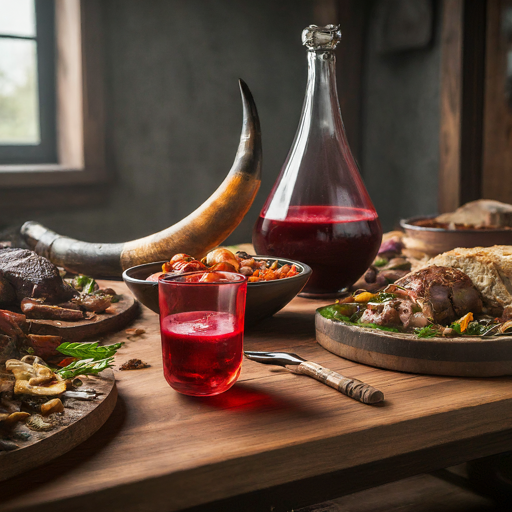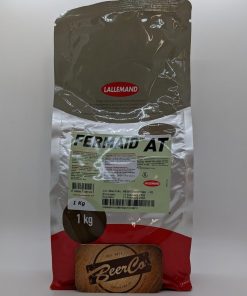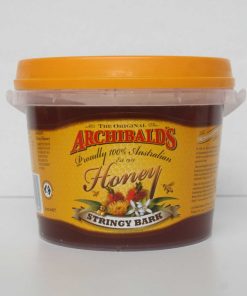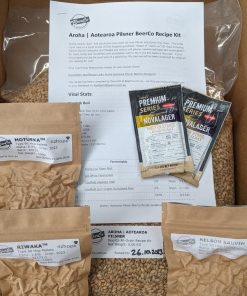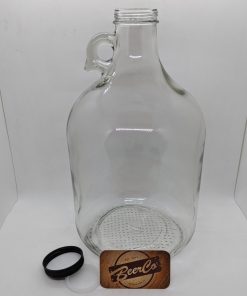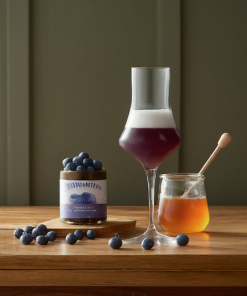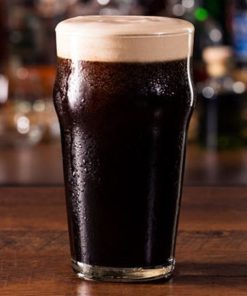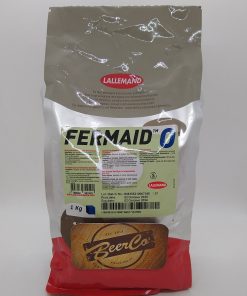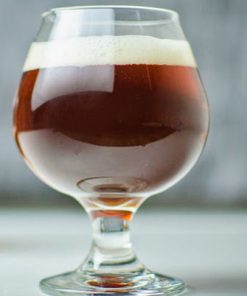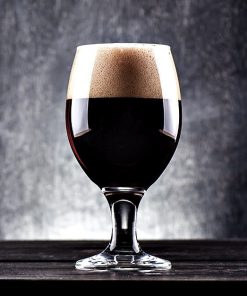Ragnar | Viking Blood Mead “Blod Mjød” | Mead Recipe Kit BeerCo.au
$ 69,95 $ 34,98
Vikings were renowned for their feasting and frivolity. Drinking was a daily occurrence in almost all Viking societies. One of the most iconic tipples was the striking “Blood Mead” (Blod Mjød). This crimson concoction was created by fermenting honey with tart cherries and hibiscus, bringing out the sweetness of the flower and enhancing the bitter-tart flavour. Why not unleash your inner Viking within and brew a magic batch of Blod Mjød. Skål!
Ragnar | Viking Blood “Blod Mjød” | Mead Recipe
written by Jimmy from BeerCo.au
Vital Stats:
- Batch Sizes: 5 Litres OR 10 Litres
- OG: 1.062
- FG: 1.000
- ABV: 8.5%
Recipe Kit Contents:
SINGLE BATCH (5 Litres):
- 2 Kg Archibald’s Honey | Floral
- 1 x M05 Mangrove Jack’s Mead Yeast 10g Sachet
- 1 x Mangrove Jack’s | Wine Yeast Nutrient
- 100g Hibiscus Flower
- ½ American Oak | Infusion Carboy Spiral | Medium Toast
DOUBLE BATCH (10 Litres):
- 3 Kg Archibald’s Honey | Floral
- 1 x M05 Mangrove Jack’s Mead Yeast 10g Sachet
- 1 x Mangrove Jack’s | Wine Yeast Nutrient
- 100g Hibiscus Flower
- 1 x American Oak | Infusion Carboy Spiral | Medium Toast
Additional Ingredients and Equipment Required:
- 1.33kg Tart Cherries (whole, with pits) OR 1kg Tart Cherries (pitted) [Single Batch]
- 2.66kg Tart Cherries (whole, with pits) OR 2kg Tart Cherries (pitted) [Double Batch]
- Plastic Fermenter and Natural Tap
- 1 Gallon / 5 Litre Demijohn(s)
- 36mm – 45mm Bung | Bored
- S-Type Airlock Bubbler and Grommet for Airlock
- Hydrometer
- Digital Pocket Thermometer
- 250ml Glass Measuring Cylinder
- Easy Siphon
- 10mm Hose Tubing (Approx. 3m)
- Blue Bottler with Spring
- 1 Spoon for Stirring
- 500mL Glass Swing Top Bottles
-
Muslin Cloth | 90cm x 90cm
Method:
1. Pit (optional) and freeze the cherries at least a day before starting your mead. If you bought frozen cherries, then this step is already done for you.
2. Take your cherries out of the freezer to thaw and drop 100g of hibiscus flower into a muslin cloth bag. Tie it up and place the bag into a pot with 1.5 L of water: steep on the stove over medium heat. Hold the temp at 65oC for 1-2 hours.
3. Allow the hibiscus infused water to cool, or alternatively, add 500ml of cold water to the pot to speed up the process before pouring into your fermenter. Squeeze the bag against the bottom of the pot with a spoon to withdraw the maximum amount of liquid before discarding the hibiscus.
4. Fill your fermenter/ brew bucket with approx. 4.7 L of water, remembering to subtract your hibiscus infused water from this calculation. Add in 1.15kg honey and stir until combined.
5. If you have not already weighed, out 1.33kg cherries (whole, with pits) OR 1kg cherries (pitted).
Optional: For better flavour extraction crush your cherries just enough to open them up (a sanitized potato masher works well) – only do this if using pitted cherries.
6. Throw the cherries into the fermenter and aerate the must.
7. Pitch ½ a packet of Mangrove Jack’s M05 Mead Yeast. Ferment between 15oC – 30oC.
8. 24 hours after pitching the yeast open your fermenter and wet the floating cherries by pushing them into the liquid using a sanitized spoon – this is to prevent mould. Then degas (gently stir) the mead. Now open the Mangrove Jack’s Wine Yeast Nutrient and distribute approx. ⅙ of the contents into the mead. Aerate for 1 – 2 mins.
9. Repeat the previous step at 48 and 72 hours.
10. Punch the fruit cap (wet the cherries) once a day for the first 7 days of fermentation. Do not open the fermenter (unless taking gravity readings) after this point as you risk oxidization.
11. Once your gravity reads ≤ 1.000 and at least 3 weeks* have passed since pitching the yeast grab the ½ carboy spiral and chuck it into a 5-litre glass demijohn. Rack (syphon) your mead on top of it.
12. Leave your mead in secondary for 2 months. Check the airlock every so often in case it needs to be refilled.
13. Bulk age and/or bottle†.
*Rack after 2 weeks if using whole cherries; it is important to get the mead off the cherry pits. If you choose to take a gravity reading at this time and it does not read ≤ 1.000 wait an additional 2 weeks before racking a second time – proceeding with step 11.
†Refer to the section on Stabilisation and Back Sweetening below.
NOTE:
– Everything that touches the honey and eventually mead at all stages throughout the process must be clean, rinsed and sanitized to avoid infection.
– If brewing a Double Batch times all measurements by two.
– The calculations given in the stabilisation and back sweetening guide are calculated for this particular mead at the stated ABV.
STABiLISATION AND BACK SWEEENTING:
Ragnar is intended to be a sweet mead. The following is a brief outline on two different methods in order to achieve this.
METHOD 1:
1. Confirm your mead has finished fermentation via a gravity reading of ≤ 1.000. Ideally, this will be done once your mead has started to clear.
2. Crush one Campden Tablet (Potassium Metabisulfite) into a powder. Then using a scale that can accurately measure down to 0.01 decimal places weigh out 1.26g of Potassium Sorbate.
3. Take a small sample of the mead and stir until both additives have completely dissolved.
4. Pour the sample into an empty 5 litre demijohn and rack your mead on top of it.
5. Allow at least 24 hours to pass before weighing out 350g of honey.
6. Pour the honey into the mead and gently stir until combined, taking care not to cause a whirlpool or aerate the mead. If after 5 or so minutes of slowly stirring there is still some undissolved honey don’t worry about it, this will sort itself out over the next couple of days.
7. Take a gravity reading before replacing the airlock – It should be right round 1.020.
8. Give your mead at least a week before confirming fermentation has not restarted. If the gravity matches what it did a week prior, you can move onto bottling.
WARNING: If you do not have all the established ingredients/ equipment in order to safely perform stabilisation via chemical additives DO NOT attempt to add additional honey into the demijohn – you will restart fermentation. Bottling while yeast are actively fermenting will cause bottles to explode, risking hospitalisation.
METHOD 2:
1. Ideally, once your mead has cleared, bottle as per step 13.
2. When you’re ready to drink some mead, go grab the leftover honey that wasn’t used during primary fermentation.
3. Pour your mead into a glass (Serving Suggestion: 150ml).
4. Spoon out about ½ tsp‡ of honey and stir into the mead.
5. Consume the Nectar of the Gods!
‡Adjust the amount of honey according to taste.
Knowledge Resource and Further, Listening, Reading & Watching about Viking Blood Mead “Blod Mjød”:
- What is Viking “Blod Mjød” (Blood Mead)?
- Viking Blood Mead – What’s the Big Deal?
| Size | 5 L, 10 L |
|---|
Fast shipping and professional packing
We offer a wide range of shipping options due to our long-running partnerships with UPS, FedEx and DHL. Our warehouse staff are highly trained and will package your items according to our precise and precise specifications. Before shipping, all goods are thoroughly inspected and securely secured. Every day we ship hundreds of packages to our customers from all over the world. This is a sign of our commitment to be the largest online retailer worldwide. The warehouses are located situated in Europe as much as they are in USA.
Note: Orders containing multiple items will have a different processing period for each item.
Before shipping the items, our staff will carry out an extensive inspection of the products you have ordered. The majority of orders are delivered within 48 hrs. The delivery time should be between 3-7 working days.
Returns
We don't manage the stock in our factory and warehouse. Actual stock levels may fluctuate at any moment. Be aware that it's possible that your order will be out of stock after you have placed the order.
Our policy is for 30 days. Unfortunately, if 30 days have passed from the date you purchased the product, we are unable to offer you a return or exchange.
The item must not be used, and it must be in the original packaging. It must also be in the original packaging.
Related products
Equipment
Brewing Aids
Equipment
Equipment
Equipment
Equipment
Equipment
Brewing Aids
